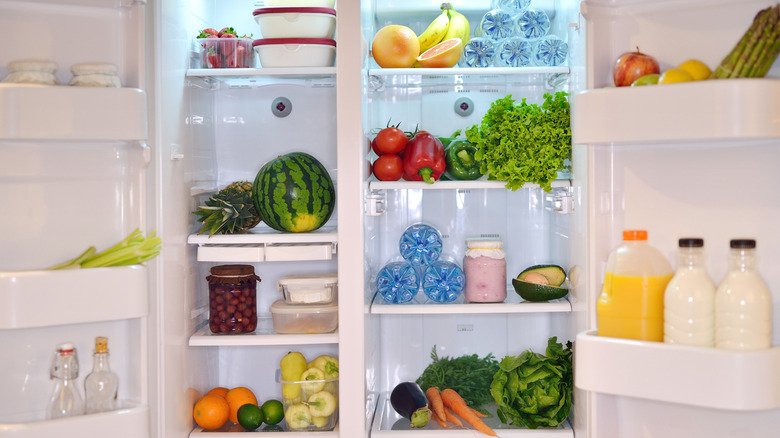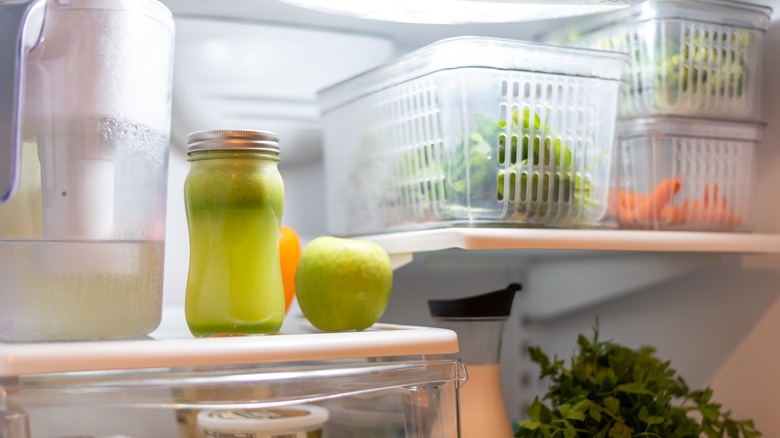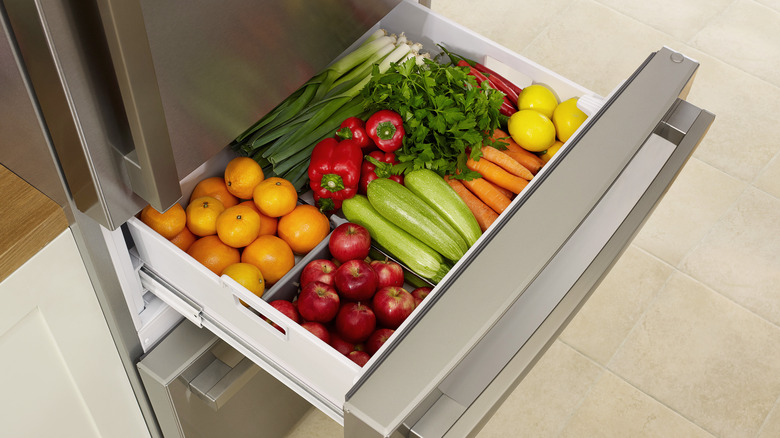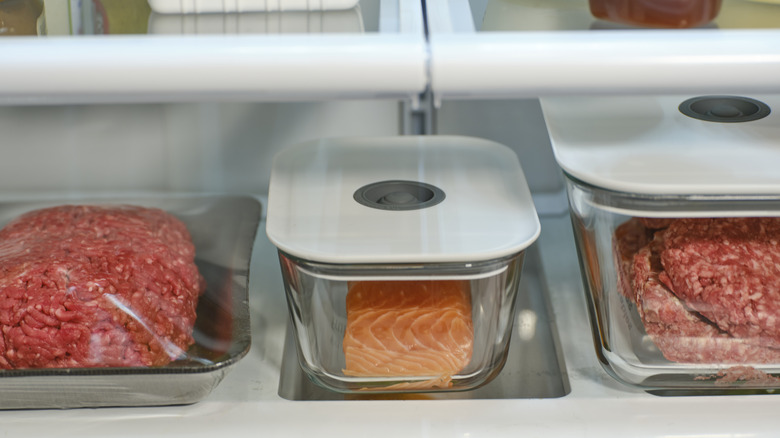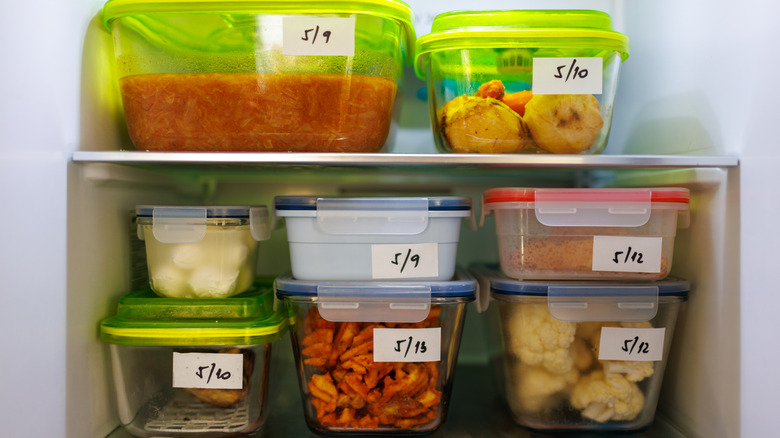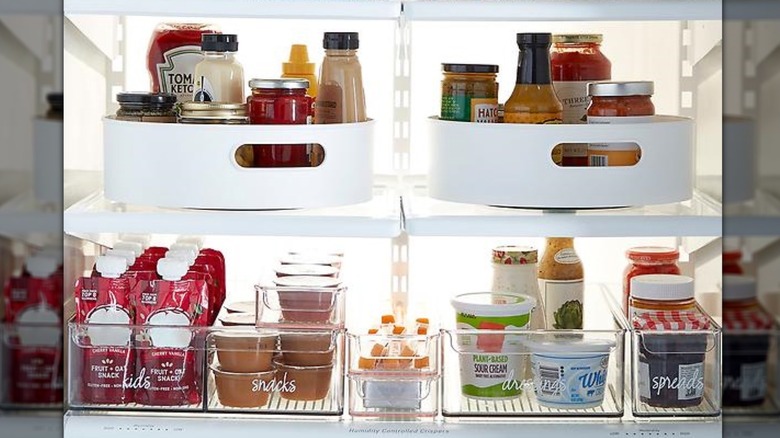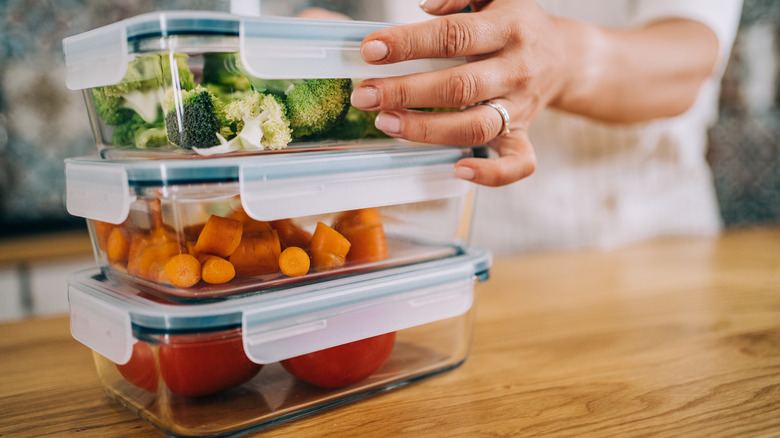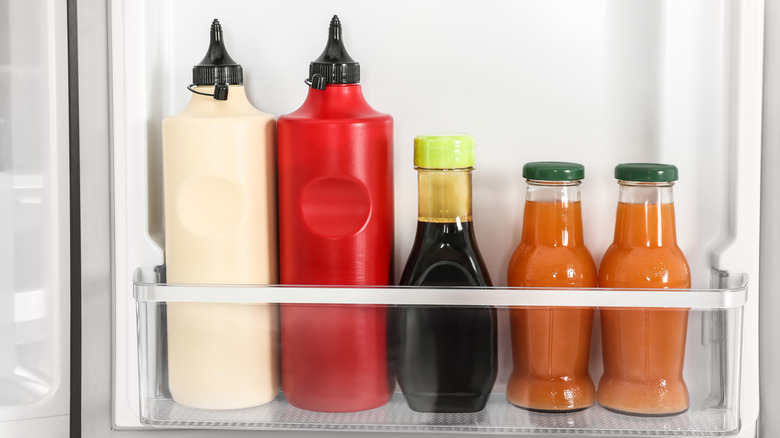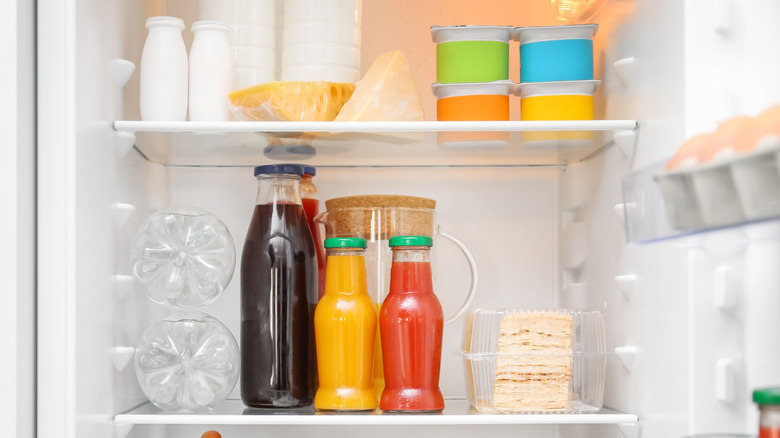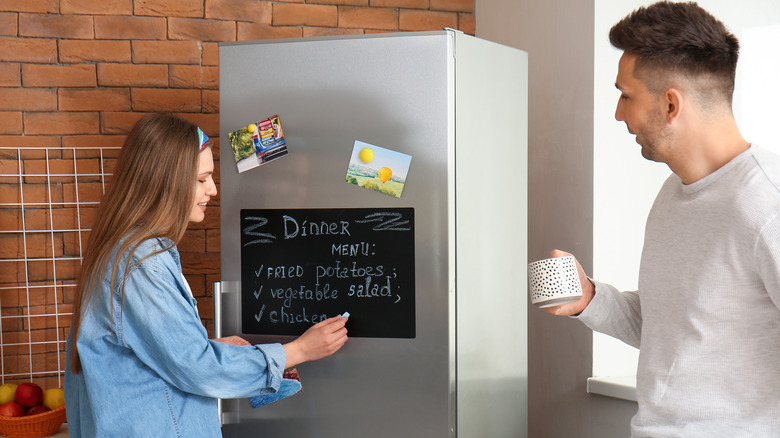The Most Common Mistakes To Avoid When Organizing Your Fridge
A strategically-organized refrigerator is a vital part of efficient kitchen management and smooth functionality. Often, individuals grapple with issues such as items vanishing into the abyss of the fridge, ingredients succumbing to premature spoilage, and the frustrating hunt for specific components. However, these pitfalls can all be avoided with the implementation of smart organizing strategies. An organized fridge has several benefits including time saved looking for the things you need, the reduction of waste, and the prolonging of your groceries.
When you embrace specific organizational practices, your refrigerator evolves into a haven that streamlines meal preparation. However, there are several common mistakes that can happen when popping in and out of such a frequently used appliance, but they are all easy to work around. Here are some common ones to avoid when organizing your fridge and the best practices to follow to create a smooth and functional food storage system.
Overcrowding the top shelves
One misstep that frequently trips people up is overcrowding the top fridge shelves. Shoving everything in easy-to-reach spots might seem like a time-saving victory, but it's a slippery slope to food expiring well before its time. Overpacking these shelves can also disrupt the airflow which ensures uniform cooling. This can lead to certain areas being more chilled than others, promoting faster spoilage and the appliance to work harder to overcompensate for the problem. To avoid this common mistake, craft specific zones in your fridge. Think of it like browsing a bookstore with different genres, except it's for food.
Start by removing all the contents inside and dividing them into similar groups. Then, decide where each one will be stored. Not sure where the best spot for each category should go? Reserve the upper shelves for items that need mild cooling, like leftovers and ready-to-eat foods. Venture a bit lower for dairy and eggs, which thrive in the coldest parts. Drawers are the ideal homes for your produce, keeping them crisper for longer.
Not using the drawers properly
Proper utilization of produce drawers in the refrigerator is a key strategy that is often overlooked. These drawers are designed with humidity control features that are designed to maintain the freshness of fruits and vegetables. By understanding and utilizing the correct humidity settings, you can significantly extend the shelf life of these items. The controls, typically labeled as "low" and "high," allow you to tailor the environment within the drawers to the needs of your produce. Adjusting them to "high" creates a more humid environment suitable for items prone to wilting, such as leafy greens. Setting it to "low" is ideal for vegetables that are sensitive to excess moisture.
Some fruits release ethylene gas, which can accelerate the ripening process of nearby vegetables. That's why, for the best fridge organization, keep fruits and vegetables separated within the drawers. If you're looking for enhanced techniques, use drawer dividers. These will segment the drawer into compartments, preventing produce from mingling and ensuring that each item retains its intended freshness. When you master the art of crisper drawer usage, you'll notice an instant change in the lifespan of your produce as well as being able to find things more easily.
Improper storage of raw meat
An organizing mistake that directly impacts food safety and longevity is the improper storage of raw meat. The problem here lies in the risk of cross-contamination. According to Healthline, uncooked and raw meat contains a lot of bacteria such as Salmonella, E.coli, and Listeria, among others. To minimize this problem, allocate the bottom shelf of the refrigerator for this product. This strategic placement prevents any potential dripping or leakage from coming into contact with other items in the fridge. For an additional layer of precaution, use a separate container or plastic bag to enclose the meat.
Another great solution is to use meat trays equipped with drainage groves. These serve as efficient tools to collect and contain any liquids that may seep from the packaging. They're designed to segregate meat from other items, promoting a hygienic and organized environment. If you're interested in a more eco-friendly option, reusable silicone bags offer a sustainable alternative to disposable plastic ones. These are leak-proof and easy to clean and provide dedicated storage for raw meat while reducing single-use plastic and contamination.
Not labeling or dating leftovers
We're all guilty of storing leftover meals that are forgotten about and eventually discarded because they are no longer good. If you're prone to putting leftovers away only to ignore their existence, it's time to use the magical art of labeling and dating. Before adding containers to the fridge, assign an eat-by date to it. This way, when mealtime beckons and you're in the mood for something quick, these labels act as your ally, letting you know what needs to be eaten soon.
Labeling can help you organize leftover things like meat, cheese, or canned goods as well. For example, if you're storing excess ingredients from a recipe in another container, make sure you label it with the expiration date from the original packaging. To ensure proper labeling, get a water-resistant marker and adhesive labels. Anytime you plan on adding something new to the shelves, mark it with the date. Then, rotate the newest ones to the back and store them at your sightline so they are the first thing to catch your eye when hunger strikes.
Rotating items regularly
When you don't regularly rotate products, the balance between flavor excellence and food waste is disrupted. To make this a habit, create a routine after every grocery trip, and conduct a brief assessment. Reallocate older stock to the forefront, allowing newcomers to claim positions in the rear. This deliberate rotation ensures that no ingredient fades into obscurity.
Aside from rotating items after every trip to the supermarket, practice a "First In, First Out" (FIFO) rule. Make an effort to use up older items first and carefully plan meals to avoid wasting outdated ingredients. To really set this philosophy to work, designate a "rotation day." This can be a weekly routine where you'll sift through the shelves, removing those that have met their untimely fate. You may also want to move certain items into clear, stackable containers as they help you see what needs to be used up of each ingredient.
Not expanding on built-in storage
Improper storage is a common pitfall that can render your fridge a hodgepodge of mismatched temperatures and diminishing flavors. The best counter to this problem is enhancing the functionality of your built-in shelves using strategic additions that optimize storage. Invest in fridge organization products like acrylic bins that will help you keep similar items together. Lazy Susans are great for making condiments and dressings easier to grab. You can add can or bottle organizers, shelf risers, and even washable mats if your fridge is prone to spills and messes. Every organized enhancement contributes to a refrigerator that helps you store items properly.
As for the ideal placement of certain products, focus on the following guidelines when putting groceries away. Dairy products deserve the chillest embrace so nestle them in the coldest part of the icebox, which is usually near the back. Keep eggs in their original carton on one of the middle shelves to shield them from temperature fluctuations. Lettuce thrives in a high-humidity environment so wrap it in a damp cloth and place it in a resealable bag on a shelf or in a crisper drawer. Meanwhile, butter should be stationed near other dairy items for easy access.
Not using transparent containers
Transparent containers are the unsung heroes of fridge organization and yet many people still don't use them or don't use them well. Whatever you store in them, a single glance reveals your stockpile, whether it's leftover lasagna or a gathering of condiments. And they provide you with this image without the need to pry open lids or shift things around to read the labels. To harness the full potential of this product, invest in a variety of sizes, from small and stackable to larger options that accommodate diverse portions.
Focus on buying ones from the same set as this gives your fridge a uniform look but also has the added advantage of nesting them together when not in use. Opt for ones with airtight seals to ensure optimal freshness and prevent any aromatic intermingling. With these containers at your disposal, your fridge transforms into a well-orchestrated visual feast.
Placing the wrong items on the door
The fridge door, often deemed a convenient catch-all, harbors a realm of debate about what truly belongs within it. This crossroads bears witness to a delicate tug-of-war between accessibility and preservation. What many overlook is that this area is prone to experiencing temperature shifts each time it opens, which can compromise the quality of certain products. So, meticulous organization is essential to ensure that this space serves its purpose without ruining the integrity of your items.
Following a few guiding principles can help you keep this section efficient and organized. Resilient condiments like ketchup, mustard, and pickles are well-suited for this terrain. Their hearty constitution withstands the temperature fluctuations and the constant in-and-out cadence of the door dance. And don't forget that like-with-like rule. It can serve wonders when dealing with the shelves. Dairy products, on the other hand, require more stability and should be relegated to the main body of the fridge, where temperatures remain steadier.
Not adjusting the shelves
The versatility of modern refrigerators lies in their adjustable shelves, a vital tool in the orchestration of a well-organized fridge. These shelves offer the flexibility to customize the interior layout, allowing you to accommodate items of varying sizes and shapes with ease. By fine-tuning the shelf heights, you can create a space where your food coexists harmoniously.
Have you ever had something slightly large to hold in a fridge, but no space to keep it safely? Whether it's a large bottle of juice, a celebratory cake, or a bulky food container, the ability to modify shelf height ensures that every item finds a suitable place. This adaptive feature optimizes storage capacity, preventing overcrowding and ensuring that items retain their freshness. It's a practical approach that brings order to your refrigerator, transforming it into a tailored space that caters to your needs. Just know that you can always adjust the shelves again if something is not working, making you the master of an optimal fridge and its available space.
Neglecting regular cleaning
A disorganized and unclean refrigerator not only poses health risks due to potential food contamination but also undermines the thoughtfulness of your storage system. That's why neglecting routine cleaning can have far-reaching consequences. Addressing spills promptly is a fundamental practice to prevent the proliferation of harmful bacteria. You'll also want to create a systematic approach to removing expired items as this is essential to maintaining a clutter-free environment that supports efficient organization.
Start by implementing a structured fridge cleaning schedule. Designate a specific day each month to perform a thorough cleaning routine. During this time, remove all items from the refrigerator, clean the surfaces using a mild cleaning solution, and ensure that spills and stains are dealt with. You can also mix equal parts hot water and vinegar into a spray bottle for this step. As part of your cleaning regimen, incorporate a regular inspection of items for expiration dates. This practice prevents the accumulation of expired products that can clutter your fridge.
Not using the exterior's vertical space
When you're focusing on the interior space of your refrigerator, it's easy to ignore the vast potential of the exterior. The sides of your fridge are prime real estate for magnetic or adhesive hooks that offer a creative solution for hanging lightweight essentials like kitchen towels, oven mitts, or a grocery list. Need a marker handy when labeling foods and leftovers? Get one with a magnetic cap to keep on the outside of your appliance.
If your fridge has a non-metallic surface, adhesive hooks offer a versatile alternative. Just make sure they're placed in areas that don't obstruct the opening of the fridge. If you want to give the exterior a touch of personality, you can create an art gallery of family snapshots or magnets that represent your home's style. It's also a good spot for your Family Command Center where you can keep chore lists, meal plans, and activity schedules. No matter how you use the exterior space of your fridge, know that it's an expansive canvas of convenience just waiting to be explored.
